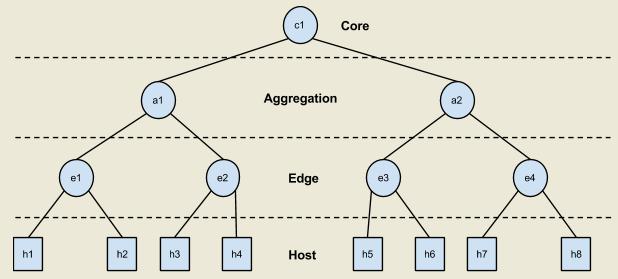在Coursera SDN开放课程中,编程作业要用Mininet来完成。这里对Mininet做一个简单的介绍。
什么是Mininet
Mininet是由一些虚拟的终端节点(end-hosts)、交换机、路由器连接而成的一个网络仿真器,它采用轻量级的虚拟化技术使得系统可以和真实网络相媲美。
Mininet可以很方便地创建一个支持SDN的网络:host就像真实的电脑一样工作,可以使用ssh登录,启动应用程序,程序可以向以太网端口发送数据包,数据包会被交换机、路由器接收并处理。有了这个网络,就可以灵活地为网络添加新的功能并进行相关测试,然后轻松部署到真实的硬件环境中。
Mininet的特性
可以简单、迅速地创建一个支持用户自定义的网络拓扑,缩短开发测试周期
可以运行真实的程序,在Linux上运行的程序基本上可以都可以在Mininet上运行,如Wireshark
Mininet支持Openflow,在Mininet上运行的代码可以轻松移植到支持OpenFlow的硬件设备上
Mininet可以在自己的电脑,或服务器,或虚拟机,或者云(例如Amazon EC2)上运行
Mininet提供python API,简单易用
Mininet是开源项目,源代码在这里:https://github.com/mininet
……
Mininet安装
使用VirtualBox安装Mininet虚拟机:http://mininet.org/download/
使用Mininet创建一个网络
以Coursera SDN Week3 programming assignment为例,创建一个及其简单的数据中心网络。
Data center networks typically have a tree-like topology. End-hosts connect to top-of-rack switches, which form the leaves (edges) of the tree; one or more core switches form the root; and one or more layers of aggregation switches form the middle of the tree. In a basic tree topology, each switch (except the core switch) has a single parent switch. Additional switches and links may be added to construct more complex tree topologies (e.g., fat tree) in an effort to improve fault tolerance or increase inter-rack bandwidth.
In this assignment, your task is to create a simple tree topology. You will assume each level i.e., core, aggregation, edge and host to be composed of a single layer of switches/hosts with a configurable fanout value (k) looks like:

代码:
# CustomTopo.py
'''
Coursera:
- Software Defined Networking (SDN) course
-- Module 3 Programming Assignment
Professor: Nick Feamster
Teaching Assistant: Muhammad Shahbaz
'''
from mininet.topo import Topo
from mininet.net import Mininet
from mininet.node import CPULimitedHost
from mininet.link import TCLink
from mininet.util import irange,dumpNodeConnections
from mininet.log import setLogLevel
class CustomTopo(Topo):
"Simple Data Center Topology"
"linkopts - (1:c1, 2:aggregation, 3: edge) parameters"
"fanout - number of child switch per parent switch"
def __init__(self, linkopts1, linkopts2, linkopts3, fanout=2, **opts):
# Initialize topology and default options
Topo.__init__(self, **opts)
# Add your logic here ...
self.fanout = fanout
core = self.addSwitch('c1')
for i in irange(1, fanout):
aggregation = self.addSwitch('a%s' %i)
self.addLink(core, aggregation, **linkopts1)
for j in irange(1, fanout):
edge = self.addSwitch('e%s' %(fanout*(i-1)+j))
self.addLink(aggregation, edge, **linkopts2)
for k in irange(1, fanout):
host = self.addHost('h%s' %((fanout*(fanout*(i-1)+j-1))+k))
self.addLink(edge, host, **linkopts3)
topos = { 'custom': ( lambda: CustomTopo() ) }
def simpleTest():
"Create and test a simple network"
linkopts1 = dict(bw=10, delay='3ms', use_htb=True)
linkopts2 = dict(bw=8, delay='4ms', loss=1, max_queue_size=900, )
linkopts3 = dict(bw=6, delay='5ms', loss=1, max_queue_size=800)
topo = CustomTopo(linkopts1, linkopts2, linkopts3, fanout=2)
net = Mininet(topo, host=CPULimitedHost, link=TCLink)
net.start()
print "Dumping host connections"
dumpNodeConnections(net.hosts)
print "Testing network connectivity"
net.pingAll()
net.stop()
if __name__ == '__main__':
# Tell mininet to print useful information
setLogLevel('info')
simpleTest()
在mininet虚拟机上执行下面操作即可创建自定义的网络拓扑。函数simpleTest()创建网络并进行了简单的ping测试,从屏幕输出可以看到创建的过程。
mininet@mininet-vm:~/mininet$ sudo python CustomTopo.py
更多资料
1. Mininet: http://mininet.org/
2. Mininet wiki: https://github.com/mininet/mininet/wiki
